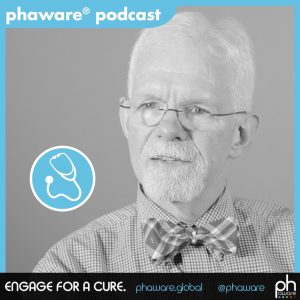Phaware podcast: George Mallory, MD

This podcast series, created and produced by phaware, is being offered as a regular guest feature on Pulmonary Hypertension News to bring the voices and life experiences of PH patients, family members, caregivers, healthcare specialists, and others to our readers. You may listen to the podcast directly, or read it via the transcript that runs below.
I’m Aware That I’m Rare: George Mallory, MD
The phaware® interview (Episode 91)
George B. Mallory, MD is a pediatric pulmonologist at Texas Children’s Hospital. In 2001, he joined the Baylor College of Medicine pediatric faculty and founded the TCH Lung Transplant Program. Since 2005, Dr. Mallory has also been medical director of the region’s only pediatric pulmonary hypertension program. In this episode, Dr. Mallory discusses the importance of the Pediatric Pulmonary Hypertension Guidelines.
My name is Dr. George Mallory. I work at Texas Children’s Hospital. I’m a member of the faculty at Baylor College of Medicine, and I’m the medical director of both the pulmonary hypertension and lung transplant programs at Texas Children’s.
There’s been a perception within both the pulmonary and the cardiology communities in pediatrics, that this relatively rare set of diseases has been set back by lack of standardization, lack of extensive research. The decision was made to bring together a large number of individuals, mostly from North America, but some beyond, to try to review the literature and come up with some recommendations, largely for physicians caring for these children. It’s getting very complicated, and this was really a good time to try to sort things through and try to define what we know and what we don’t know.
of standardization, lack of extensive research. The decision was made to bring together a large number of individuals, mostly from North America, but some beyond, to try to review the literature and come up with some recommendations, largely for physicians caring for these children. It’s getting very complicated, and this was really a good time to try to sort things through and try to define what we know and what we don’t know.
I was one of the pulmonologists on the committee, and my area to cover was the association of pulmonary hypertension with lung disease. We know in adults that the most common disease that is associated with pulmonary hypertension is heart disease, and it’s probably true in pediatrics. At least there’s been a lot of attention on congenital heart disease and its association with pulmonary hypertension, but not so much the association of a variety of different lung diseases in childhood with pulmonary hypertension.
It was my task, with a small number of partners, to review the literature and then summarize what we know about rare diffuse lung diseases in infants and young children, more common diseases like sleep apnea, cystic fibrosis, and their association with pulmonary hypertension.
We believe that the spectrum and the variety of disease within pulmonary hypertension in childhood is far more diverse than it is in adults. Clearly, babies are very different from young children, who are very different from older children and adolescents. The number of different kinds of diseases is very different, so there are many challenging variations on the disease. When we have a group together with a ListServ, there’s an opportunity for physicians to pose questions, to share their experience, to help with problem-solving.
We’re starting to see insurance companies challenge the use of medications for pulmonary hypertension in children. We all know that none of them are approved by the Food and Drug Administration specifically for children, and it means that there really aren’t the extensive studies in infants and children in the use of these medications.
However, because pulmonary hypertension is at least as potentially lethal, if not more so, from the very beginning, and Dr. Robyn Barst was an example of this, there’s been a willingness and a boldness to apply, in very careful ways, the same medications that our adult colleagues have used in infants and children.
I think those of us who do this a lot, and talk with each other, participate in the [pediatric] guidelines, and participate in PPHNet, that we feel that these medications are generally safe and effective in our patients. There is no cookbook that works for every child or every disease. That’s one of the things that, frankly, still thrills me about being involved in the care of children with pulmonary hypertension.
There is a large number of classifications. We call it the World Health Organization Classification of Diseases, and there certainly are many different diseases in adults, but it looks a bit different in childhood. I would say in the area that I covered in lung diseases, our lung diseases are different, as they associate with pulmonary hypertension, than the adult diseases.
But what we have found is, if you’ve got a form of interstitial lung disease in adulthood, which almost never occurs in childhood, studies have shown that the addition of pulmonary hypertension to that disease is an ominous sign. Those are patients who are at risk for dying and may be an indication in which to consider the pros and cons of lung transplantation. We have found the same thing in childhood, again, different set of diseases. We’re talking about diffuse diseases of the lung. When there’s pulmonary hypertension, it’s often a warning sign.
Getting an echocardiogram, thinking about pulmonary hypertension, is not really one of the primary considerations in many adult and pediatric pulmonary physicians. I think the guidelines will help in this regard, whether the use of PH medications will alter the prognosis and the disease trajectory is something that we’re still trying to figure out.
EVERYBODY HAS A STORY. WHAT’S YOURS?
Phaware global association wants to share your pulmonary hypertension story with their engaged global audience. Whether you are a patient, caregiver, or medical professional, they are enlisting PH community members from around the world. Visit www.phawarepodcast.libsyn.com/contact to share your story and to be considered for a future episode. Never miss an episode with the phaware® podcast app. Learn more about pulmonary hypertension at www.phaware.global. #phaware
***
Note: Pulmonary Hypertension News is strictly a news and information website about the disease. It does not provide medical advice, diagnosis, or treatment. This content is not intended to be a substitute for professional medical advice, diagnosis, or treatment. Always seek the advice of your physician or other qualified health provider with any questions you may have regarding a medical condition. Never disregard professional medical advice or delay in seeking it because of something you have read on this website. The opinions expressed in this column are not those of Pulmonary Hypertension News or its parent company, BioNews Services, and are intended to spark discussion about issues pertaining to pulmonary hypertension.










Comments